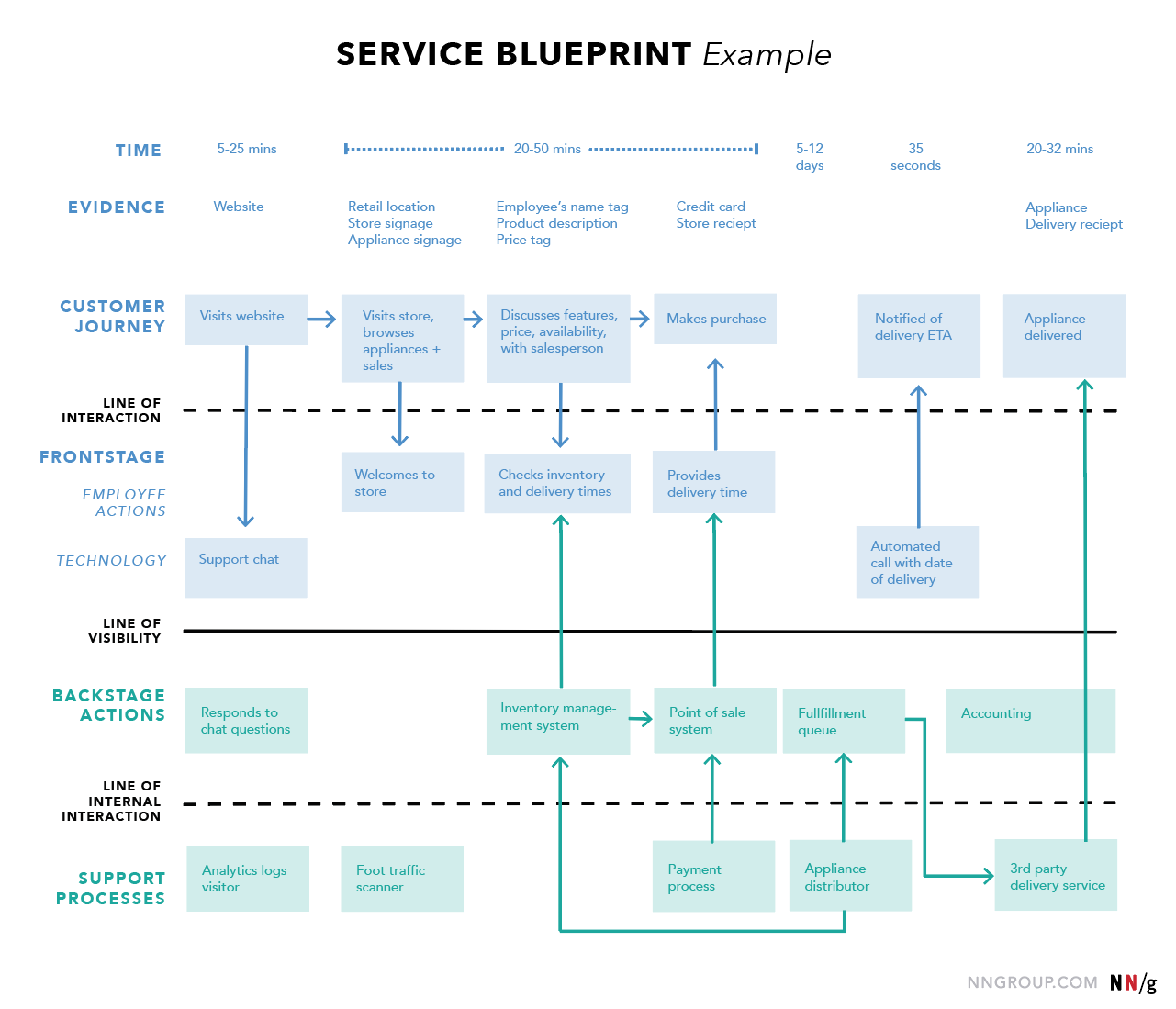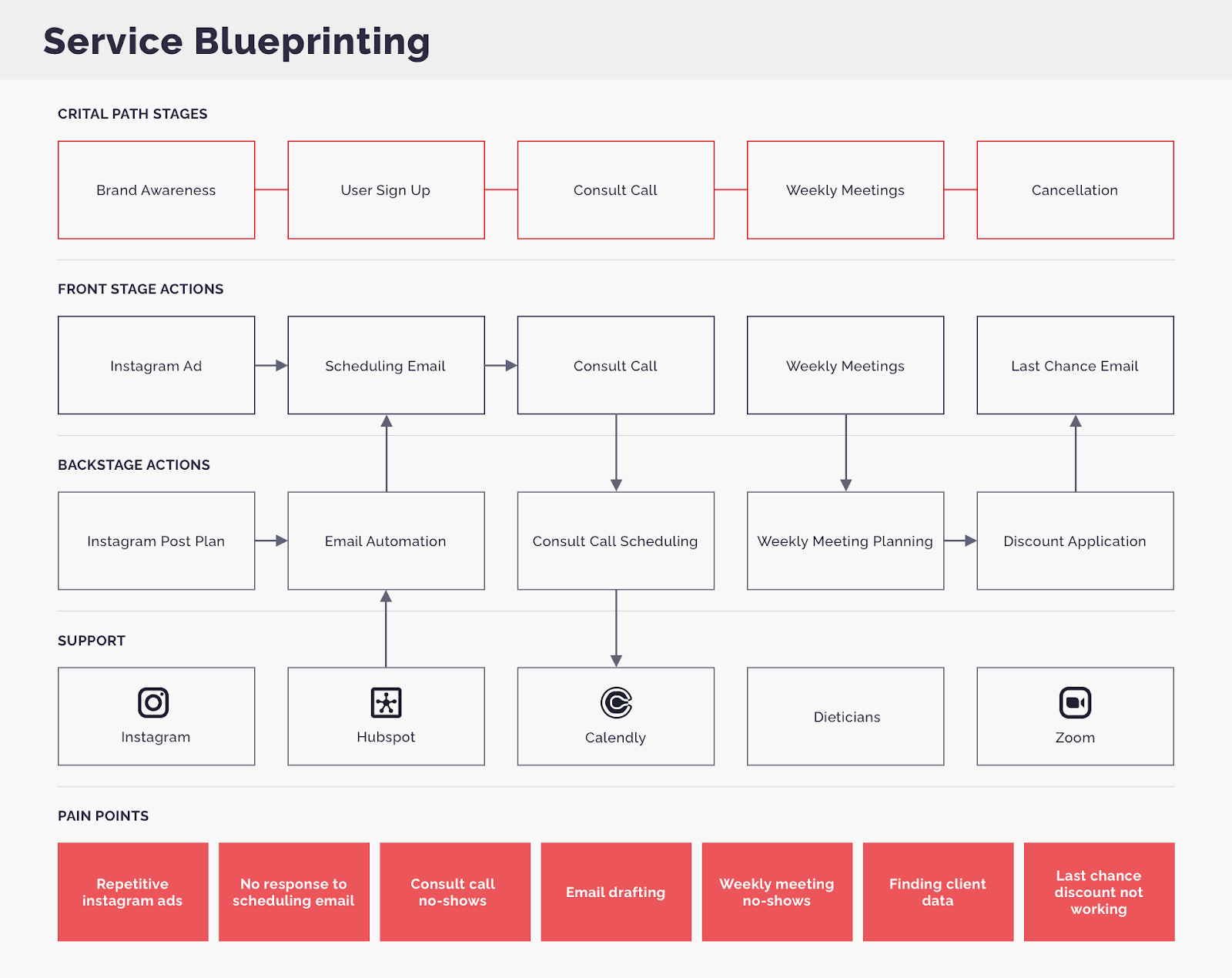Content strategy is integral to service design as it ensures that the right information is delivered in a consistent, clear, and engaging manner, ultimately enhancing the overall user experience and effectiveness of the service.
Service design meets content strategy #
As part of our Content Strategy program, we had the distinct pleasure of attending a guest lecture by Amy Marie Phillips, an expert in service design. This enlightening session provided an in-depth exploration of service design and highlighted its significant intersection with content strategy. Through engaging activities and detailed discussions, we gained a profound understanding of how these two fields can work in tandem to create exceptional user experiences.
What is Service Design?
Amy introduced us to service design through a simple yet effective exercise to kick off the session. We were asked to imagine two adjacent coffee shops offering identical coffee at the same price. Our task was to determine why we might choose one over the other. This prompted us to consider various factors beyond just the coffee itself, such as:
- The shape and design of the coffee cups
- The seating arrangement and comfort
- The friendliness and professionalism of the baristas
- The cleanliness and ambience of the establishment
- The company's sustainability practices
This exercise taught us that service design encompasses all these elements and more. It involves designing every touchpoint and interaction a customer has with a service. This holistic approach ensures the entire service experience is seamless and satisfying for the user.
Definitions of Service Design
Amy then introduced several definitions of service design from various authoritative sources:
- Service Design Network (SDN): "Service design is the practice of designing services. It uses a holistic and highly collaborative approach to generate value for both the service user and the service provider throughout the service's lifecycle." (SDN | What Is Service Design?, o. D.)
- NN Group: "Service design aims to optimize the interplay between the customers' journey and the internal business processes that support it. There are three key components of service design: people, props, and processes."(Gibbons, 2022)
- Interaction Design Foundation: "Services should be designed based on a genuine comprehension of the purpose of the service, the demand for the service, and the ability of the service provider to deliver that service." („The Principles Of Service Design Thinking - Building Better Services“, 2024)
These definitions underscore the complexity and comprehensive nature of service design. It involves planning and arranging people, infrastructure, communication, and material components to improve service quality and enhance the interaction between the service provider and its users.

The Double Diamond and Service Design
A significant part of the lecture focused on applying the double diamond model from design thinking to service design. This model is a framework that helps in understanding the design process. It consists of four phases: Discover, Define, Develop, and Deliver.
- Discover/Empathize: The first phase involves understanding customer needs and pain points. Empathy mapping, customer journey mapping, and user research are essential in this phase. Amy emphasized that understanding and focusing on user needs ensures a shared understanding within the team and prevents the researcher from becoming the sole keeper of knowledge.
- Risks: Lack of quantitative data and the misconception that user research is a one-time activity. Continuous user research is crucial throughout all phases.
- Tool: Empathy Map Canvas
- Define: The second phase focuses on identifying the right problem to solve. Tools like problem framing and design thinking are used to ensure that the team is addressing the actual issue.
- Develop/Ideate: In this phase, the goal is to generate a wide range of ideas. Techniques such as co-design, workshops, and opportunity solution mapping are employed to brainstorm solutions based on user needs and requirements.
- Risks: Falling in love with initial ideas and failing to pivot when necessary. Based on user feedback, it's important to remain flexible and open to change.
- Tools: How might we…?
- Develop/Prototype & Test: This phase involves building and testing models to ensure the solutions are fit for purpose. Tools like wireframing, low and high-fidelity prototyping, A/B testing, and usability testing are used.
- Risks: There is a temptation to skip this step or conduct it superficially. Iteration based on user feedback is crucial for developing effective solutions.
- Deliver/Implement: The final phase involves rolling out and evaluating the solution. Tools like dashboards to measure performance and continuous improvement plans are essential to ensure the service remains effective and evolves based on user feedback.
- Risks: Delays, outages, and resistance to change. Effective change management and communication are vital to mitigate these risks.
- At this point, we ran through another exercise, where Amy acted as the business customer, and we were the design team, trying to gauge what the real problem is for a service to support seafarers getting their certifications to sail For this, we used the “just right size” problem canvas from the UK government:

Service Design and Content Strategy: A Synergistic Approach
Amy highlighted how service design and content strategy can align and enhance each other. Content strategy plays a critical role in several areas of service design:
- Marketing and Communication Strategy: Ensuring clear and consistent communication about the service across all channels. This includes deciding how, when, and to whom the service communication should be directed.
- UX Writing: Crafting clear and on-brand wording throughout the service experience, ensuring users understand and navigate the service effortlessly.
- Expectation Management involves keeping users informed about what to expect at each stage, how to seek help, and maintaining consistent communication across different touchpoints.
Amy then challenged one of the students to an exercise in which one would act as the head of design while the other would be a new content strategist joining the company but not the design team. In 15 minutes, the students would have to present themselves and their roles and set expectations on how they would work together, with the aim of working collaboratively, not against each other.
Why is this important? It’s because design and content strategy have many aspects in common:
- Both must align their work with business strategy and benefit from it, thrive in complexity and simplify it, and ensure compliance with policy, legislation, governance, brand, etc.
- Both are user-focused. They need to use qualitative and quantitative methods to understand the user, and they want them to succeed and be happy to come back.
- Finally, both are digitally skilled and data-driven, and they can support each other by sharing skills, tooling, and language.
Design and content strategy can complement each other instead of working against each other.
Service blueprints
Service blueprints are essential tools for collaboration between service design and content strategy. A service blueprint is a diagram that outlines the entire service delivery process, detailing the activities at each stage and the roles involved. This ensures a shared understanding among team members and helps identify areas for optimization.
Amy presented some examples of service blueprints to illustrate their appearance and functionality. The Nielsen Norman Group provides a comprehensive example, which can be viewed here.

This blueprint displays the actions taken during the service, highlights which parts are visible to the client and which occur “behind the scenes,” and outlines supporting processes. It can also be expanded with additional elements such as time, customer sentiment, and metrics.
Another helpful example comes from the ADK Group, which you can explore here.

Additionally, Mural offers a practical template for service blueprints, which is available here.

Creating service blueprints—visual representations of the service and its touchpoints—enables teams to visualize the service, obtain a comprehensive overview, and better understand all the interconnected elements.
Designing a Sensitive Service: A Case Study
The final exercise of the lecture was particularly impactful. We were tasked with designing a government certification service for recognizing early pregnancy loss, a sensitive and politically visible issue.
Amy approached the exercise with great sensitivity. Understanding that pregnancy loss can be a triggering topic, she provided an alternative exercise for those who preferred not to discuss it. This opt-out option was managed discreetly to ensure no one felt singled out.
The exercise required careful consideration of various user and service factors, including:
User Considerations:
- Privacy concerns
- Eligibility
- Potential for misuse
- Emotional impact on users
Service Considerations:
- Political optics
- Security
- Data sharing
- Supportive communication
Amy presented a timeline of pregnancies to deepen our understanding of the subject matter. We learned that a pregnancy loss is categorized as a stillbirth at 24 weeks, as this is when a baby can survive outside the womb; losses before this point are classified as miscarriages. This helped us determine that the certificate would only be issued for miscarriages, since stillbirths are already recognized legally as losses.
We then split into groups to discuss various aspects of the service and how they would interplay. Key considerations included:
Eligibility of Applicant:
- Can anyone living in the UK apply for this certificate?
- Do applicants need to be insured by the NHS?
Personal Situation:
- Can a mother or father apply without the other parent's knowledge?
- Can a minor apply for this certificate? What is the cutoff age?
- Can you apply without an exact date of conception or loss?
- What if the applicant doesn’t have a fixed address?
Proof:
- Is proof of loss necessary? If so, who issues it?
- Does it require consent from the GP?
- Must the GP be informed?
Misuse:
- Could there be potential for misuse or fraud?
- How can it be prevented?
We developed a blueprint incorporating these considerations and more, aiming to design a service that allows parents facing a miscarriage to receive a certificate recognizing their loss. Additionally, we discussed how content strategists could support this process by ensuring sensitive communication, clear content design on websites, and thoughtful copywriting of documents. This exercise highlighted the importance of a collaborative and user-centered approach in designing sensitive services.
Conclusion
Amy Marie Phillips' lecture on service design was a comprehensive and enlightening experience. It provided valuable insights into the intricate world of service design and its profound connection with content strategy. By understanding and applying these principles, we can create cohesive, user-centered services that meet users' needs.
By integrating service design with content strategy, we can ensure a holistic, effective, and user-centric approach to designing and delivering services.
Where to go from here #
For further reading and exploration, here are some recommended resources:
- What We Mean by Service Design
- How Experience Design Roles Relate to Each Other
- The Double Diamond Design Process
- UK Government Design Principles
References #
Gibbons, S. (2022, 20. Januar). Service design: study guide. Nielsen Norman Group. https://www.nngroup.com/articles/service-design-study-guide/
SDN | What is Service Design? (o. D.). Service Design Network. https://www.service-design-network.org/about-service-design
The Principles of Service Design Thinking - Building Better Services. (2024, 21. Juni). The Interaction Design Foundation. https://www.interaction-design.org/literature/article/the-principles-of-service-design-thinking-building-better-services
The blog post was written based on the Service Design lecture for COS23 in June 2024 and was authorized by Amy Marie Philipps.

